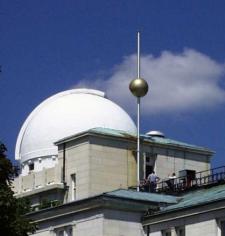
The USNO Millennium Time Ball
Last night in New York City, over one million people watched a jeweled ball drop in Time Square at exactly midnight to mark the arrival of the New Year. Over a billion people are believed to have watched the festivities on television or on-line. The six-ton Waterford crystal ball covered in 32,276 LED lights is not actually “dropped” but lowered from a flag pole on the roof of One Times Square. In New York City, the tradition dates back to 1907. But where did the tradition of dropping a ball to mark the time originate? The practice dates back to 1829 and was related to helping sailors calculate their position at sea. Here is an updated post from several years ago.
When out of sight of land, a navigator can determine latitude, his position north or south on the globe, by measuring the altitude of the sun using only a sextant and a nautical almanac. To determine longitude, his position east or west, however, a navigator must compare the time of the locally observed noon with the time on his chronometer, usually set to the time in Greenwich, UK. The first chronometers rugged enough for use at sea were developed by John Harrison and others in the mid to late 18th century. By the 19th century, marine chronometers were adopted on naval ships and many merchant vessels.
But how could a navigator easily and precisely set his ship’s chronometers? To solve this problem, the Royal Navy’s Captain Robert Wauchope invented the time ball in 1829. It was large ball hoisted to the top of a pole on a building easily visible to ships in the harbor. The ball would be lowered at a precise time, usually noon or 1PM. When the navigators on ships in the local harbor saw the ball beginning to drop they could use it to set their chronometers to the exact time.
The first time ball was erected in Portsmouth in 1829, followed by a time ball at the Greenwich Observatory in 1833 and at the US Naval Observatory in Washington in 1845. Soon, time balls were installed in ports around the world.
In 1877, Western Union installed a time ball on its Manhattan headquarters, at Broadway and Dey Street. Its firing signal came from the Naval Observatory in Washington, via a dedicated telegraph line, which directed the ball to drop at noon New York time, or about 11:48 a.m. in D.C. At a distance, the ball appeared to be a solid ball. It actually was made up of a dozen thin semicircles made of sheet copper, half of which were crescents. This allowed for minimal wind resistance when dropped.
With the advent of radio time signals in the 1920s, the time balls became obsolete. Nevertheless, the time balls at the Greenwich Observatory and the US Naval Observatory continue to drop every day to give both locals and ships on the rivers a means of setting their watches. And, when the ball drops at midnight every year at Time Square, watched by countless millions, the bejeweled ball pays homage to Robert Wauchope’s invention, the time ball.
Happy New Year to all.

Thankyou for something new to learn.
Who Knew!
Titanic Memorial had the time ball too
https://en.wikipedia.org/wiki/Titanic_Memorial_(New_York_City)
I slept through the MYC junk, no big deal anymore.
Around the ISA, they have all kinds of drops for the new year, one was a big popcorn ball, the others I don’t remember.
There is one on Carlton Hill in Edinburgh which slowly rises then drops on the 0ne oclock time signal. It was connected by electronic cable to a cannon that fired simultaneously at Edinburgh Castle. I have seen time contour maps showing the time delay in circles from the canon, this was used to sell accurate time around the city.
https://en.wikipedia.org/wiki/Nelson_Monument,_Edinburgh
Ramsgate in Kent, England has a tidal ball to indicate when there is enough water for vessels to enter the inner (locked) harbour. It is a sort of wicker affair on a mast near the Yacht Club.
I suspect that it is no longer hoisted or dropped because the harbour is run by the penny-pinching town council. I may be wrong.
The nearest Time Ball was at Deal, just to the south.
Pingback: New York History Around The Web This Week - The New York History Blog